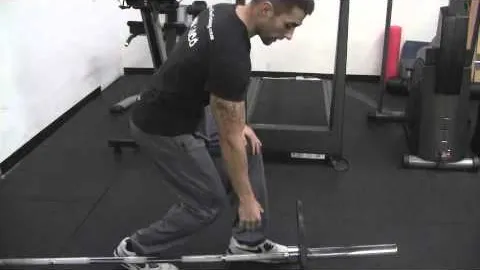

Are you looking for an effective exercise to strengthen your back muscles and improve your posture? Look no further than the unilateral barbell row! This compound exercise targets multiple muscles in your upper body, helping you build strength, stability, and balance. In this comprehensive guide, we will walk you through the proper form, benefits, and variations of the unilateral barbell row.
The unilateral barbell row, as the name implies, is a single-arm exercise that involves pulling a barbell towards your body. It primarily targets the muscles in your back, including the latissimus dorsi, rhomboids, and trapezius. Additionally, this exercise engages your biceps, forearms, and core, making it a great option for an all-around upper body workout.
Follow these step-by-step instructions to perform the unilateral barbell row with correct form:
To maximize the benefits of the unilateral barbell row and reduce the risk of injury, keep these key tips in mind:
Incorporating unilateral barbell rows into your workout routine offers numerous benefits for your overall strength and fitness. Here are some key advantages:
The unilateral barbell row is a highly effective exercise for targeting the muscles in your back, especially the latissimus dorsi. By regularly performing this exercise, you can strengthen and sculpt your back muscles, leading to improved posture and back support.
Since the unilateral barbell row is a unilateral exercise, it creates an imbalance in your body that requires your core muscles to work harder to maintain stability. This helps strengthen your core, contributing to overall stability and balance in your upper body.
In addition to targeting the back muscles, the unilateral barbell row also engages your biceps and forearm muscles. The pulling motion involved in this exercise can help develop these muscles, leading to improved arm strength and definition.
Performing the unilateral barbell row helps identify and address any muscular imbalances between your left and right sides. By focusing on each side separately, you can correct any weaknesses and imbalances, ultimately leading to improved symmetry and balance in your physique.
To add variety to your workout routine and target your back muscles from different angles, try these variations of the unilateral barbell row:
Instead of using an overhand grip, use an underhand grip (palms facing away from your body). This variation emphasizes the biceps and targets the lower lat muscles, providing a unique stimulus to your back during the rowing motion.
If you don't have access to a barbell, you can perform the unilateral row using a dumbbell. Simply bend forward, brace your hand on a bench or rack, and row the dumbbell towards your body, following the same movement pattern as the barbell row.
Assume a kneeling position with one knee resting on a bench or elevated surface. Hold the barbell with one hand and perform the rowing motion, focusing on keeping your core stable and back straight. This variation increases the activation of your core muscles.
The unilateral barbell row is a versatile exercise that targets multiple muscles in your upper body. By incorporating this compound movement into your workout routine, you can strengthen your back, enhance stability, and improve overall balance and symmetry. Remember to start with light weights, focus on proper form, and gradually increase the load as your strength improves. Add variations to keep your workouts exciting and challenging. Start rowing your way to a stronger, healthier back today!
If you're looking for a gym, fitness club or yoga studio, you've come to the right place.
You can find information about gyms in your area. Browse catalog of gyms and find gyms with classes which are you looking for.
On gym page you can find simple information like address, phone or website. You can find list of available classes. You can check availability of personal training or small group classes. On place page you can also see information about open hours.
You can find gyms near you with amenities, courts, studios and equipments.
Use our map to find gym at your city or district.
In Gym Navigator you can find list of exercises with movies for many body parts.
You can browse exercises catalog and find exercises the best of you.
You can also find exercises grouped into workout plans, which you can use to improve you body. Each routine show you exercises one by one and give you possibility to count you progress and count down rest time.